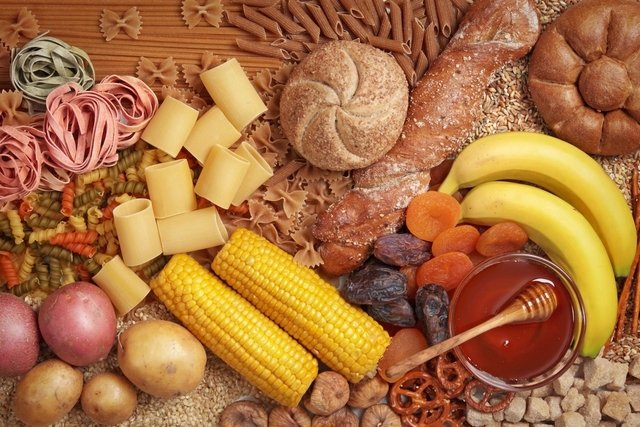Carbohydrate counting is a way of planning meals to know how much insulin should be administered before or after meals, helping to maintain adequate blood sugar levels in people with diabetes mellitus, thus avoiding possible complications such as hypoglycemia. , kidney damage and heart problems.
Furthermore, it is also important to check the nutritional information on product labels to check the amount of carbohydrates per serving of food. However, one should always take into account the type of insulin recommended by the endocrinologist, which may vary according to the practice of physical activity and the person’s general health status. Learn about the different types of insulin.
Carbohydrate counting is also useful for people with type 2 diabetes and pre-diabetes, thus helping to improve control of blood glucose levels, helping to avoid the need for medications and insulin. See other dietary tips to control type 2 diabetes.

How to count carbohydrates
To count carbohydrates, the following aspects must be taken into consideration:
1. Foods that contain carbohydrates
Carbohydrates are the main source of energy used by the body and are mainly metabolized as glucose in the bloodstream, requiring the release of insulin to balance normal blood glucose levels. Foods that contain carbohydrates are:
- Cereals, such as rice, wheat, oats, corn, bread, pasta, crackers and cornstarch;
- Legumes, such as beans, chickpeas, lentils, peas and broad beans;
- Tuberssuch as potatoes, cassava, yams and sweet potatoes;
- Vegetables, such as carrots, beets, eggplant, tomatoes, broccoli, cauliflower, green beans, kale, Brussels sprouts, lettuce, spinach and mushrooms;
- Some dairy productssuch as milk and yogurt;
- Fruits fresh, preserved and fruit juices;
- Plant-based drinkssuch as soy, oats and almonds;
- Foods rich in sugarsuch as sweets, sugar, honey, cakes, marmalade, ice cream, soft drinks, candies, biscuits and chocolate.
It is essential to distribute carbohydrate foods throughout the day between meals to control blood glucose levels.
However, carbohydrates must be distributed according to the type of insulin indicated by the doctor. When rapid insulin is administered, people are not required to adhere to a strict schedule, number of meals and types of food, therefore insulin is administered according to carbohydrate counting.
2. Amount of carbohydrates in food
To facilitate carbohydrate counting, the food exchange system is generally used, where 1 serving of each food contains 15 g of carbohydrates, except non-starchy vegetables that contain 3 to 5 g of carbohydrates. With that in mind, foods should be grouped into portions like this:
It is also important to read the product label to choose the most suitable foods and control the amount of carbohydrates consumed. Nutritional information on food labels tells you the total carbohydrates in each serving. Accordingly, you must calculate the amount of this food that contains 15 grams of carbohydrates.
Furthermore, having a small scale can also be very useful to help you calculate food portions more easily.
3. Foods that don’t need to be counted
Vegetables such as lettuce, zucchini, tomatoes, green beans, eggplant, onion and broccoli have a low carbohydrate content and are rich in fiber, containing a very low glycemic index and, therefore, do not need to be counted, when consumed up to 1 cup of the vegetable raw or ½ cup of the cooked vegetable.
Other foods that also do not need to be counted are: sugar-free drinks, such as water, teas, coffee; sweeteners; protein-rich foods, including all types of meat and eggs; foods rich in fat, such as nuts, vegetable oils, cheese; and condiments.
4. Amount of carbohydrates to eat
Carbohydrate needs for an adult are generally between 45% to 65% of total dietary calories. The amounts of carbohydrate portions vary according to weight, gender, health status and physical activity.
The general recommendations for carbohydrate consumption are:
- Between 50 and 70 g of carbohydrates at breakfast, lunch and dinner;
- Between 20 and 30 grams of carbohydrates in small snacks.
It is recommended to consume at least 130 grams of carbohydrates per day to avoid hypoglycemia, which is a condition caused by low carbohydrate intake or excessive use of medications, such as insulin, which can cause symptoms such as headache, weakness and dizziness. Learn about other symptoms of hypoglycemia.
Example for Carb Counting
The following table contains an example of carbohydrate counting for breakfast:
This way, it is possible to calculate the amount of carbohydrates in the meal to know the amount of insulin that should be administered and, thus, control blood sugar levels.
How to calculate the amount of insulin
Carbohydrate counting is generally used by people with diabetes and who use insulin, which can be slow and long-acting, or fast-acting, for example, depending on the doctor’s instructions. Learn more about the types of insulin.
It is generally recommended to administer 1 unit of insulin for every 15 g of carbohydrates consumed. However, the doctor may also recommend 1 unit of insulin for every 10 g of carbohydrates in the meal.
To know the total amount of insulin that should be administered, the following steps must be followed:
- Monitor blood glucose before each meal;
- Calculate rapid insulin units according to carbohydrate intake;
- Adjust the already calculated insulin dose, according to the blood glucose value prior to ingestion.
The following table shows how to adjust rapid insulin according to the blood glucose calculated before the meal:
Example for calculating the amount of insulin
Following the previous example, if a person is going to eat 60 g of carbohydrates for breakfast, glucose is also measured before lunch and shows 140 mg/dl. Therefore, taking into account that for every 15 g of carbohydrates, 1 unit of insulin must be administered, the following calculation must be made:
1. Divide 60 g of carbohydrates by 15 g, resulting in 4 units of insulin according to intake;
2. If the person has 140 mg/dl, 1 Unit of Insulin must be added, resulting in a total of 5 Units of insulin.
Therefore, this person must apply a total of 5 Units of insulin to be able to eat the indicated menu and keep glucose levels stable.
Benefits of Carb Counting
The benefits of carrying out carbohydrate content are as follows:
- Greater freedom in choosing meals;
- Better control of blood glucose levels;
- Flexibility in social life;
- Ease of weight control.
Additionally, carbohydrate counting also reduces the chances of complications such as hypoglycemia, kidney damage, eye problems, and cardiovascular disease. Learn more about the complications of diabetes.

Sign up for our newsletter and stay up to date with exclusive news
that can transform your routine!
Warning: Undefined array key "title" in /home/storelat/public_html/wp-content/plugins/link-whisper-premium/templates/frontend/related-posts.php on line 12
Warning: Undefined array key "title_tag" in /home/storelat/public_html/wp-content/plugins/link-whisper-premium/templates/frontend/related-posts.php on line 13



